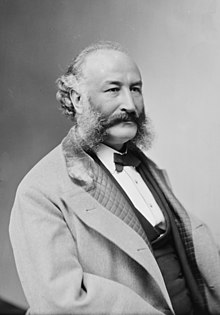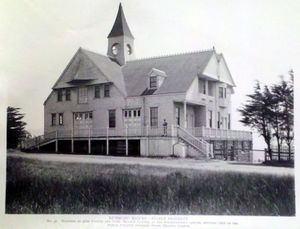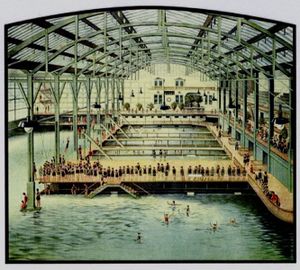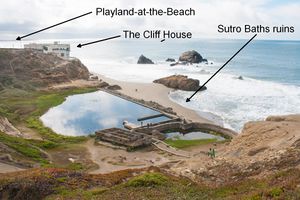Adolph Heinrich Joseph Sutro
Click here for Bay Area History category page |
Adolph Heinrich Joseph Sutro (April 29, 1830 - August 8, 1898) was the 24th mayor of San Francisco, California, serving in that office from 1894 until 1896. He is today perhaps best remembered for the various San Francisco lands and landmarks that still bear his name.
Sutro Tunnel
Born in Aachen, Prussia, Sutro, educated as an engineer, at the age of twenty arrived in the United States and in 1850, he introduced himself to William Ralston of the Bank of California and introduced his plans for de-watering and de-gassing the mine shafts of the Comstock Lode by driving a tunnel through Mount Davidson to drain the water. Sutro incorporated the Sutro Tunnel company and raised 3 million dollars, a considerable fortune through this work in Nevada. He included the miners in his scheme, and planned to sail to Europe to negotiate with the Parisian Bank, but the Franco-Prussian War commenced in the middle of July 1870. Sutro was stymied, but out of the blue came an offer from a London bank led by a banker named McClamont, who offered 650,000 in gold per year for the Comstock. Ralston was defeated.
According to Dickson; "...Sutro set off blasts of dynamite, ...leading the way for tunnel diggers. He fought avalanches, mud slides and poisonous gases. He dug air shafts to relieve the danger; the shafts filled with water, one of them to the depth of nine hundred feet. He fought cave-ins and solid rock. Through the grueling months, day after day and month after month, he marched ahead of his men, stripped to the waist, laboring with them, sweating with them, facing death with them, and in the end, winning through with them to victory."
Adolph Sutro became King of the Comstock because his tunnels drained three to four million gallons of water a day, rented by mine owners at an average of 10,000 dollars a day, "all moneys accumulated for his stockholders."
The Sutro Tunnel is a drainage tunnel located under Mount Davidson in the Comstock Lode in Northern Nevada. It begins at Virginia City and empties approximately 6 miles to the southeast, near the town of Dayton, Nevada.
The tunnel was first envisioned by Adolph Sutro in 1860. He promoted the drainage tunnel in order to allow access to deeper mineral exploration in the Comstock. Ground water had inhibited some exploration activities up to that time.
By 1865, Sutro's idea had gained the approval of state and federal legislation. The mining interests of the Comstock also initially supported the tunnel project, but later strongly opposed the idea. They feared that an alternate access point to the Comstock minerals would threaten their monopoly on the mining and milling of gold and silver in the Comstock.
Nonetheless, Sutro formed the Sutro Tunnel Company, selling stock certificates to raise funds for its construction, which began in 1869. Financing also came from local miners under the guise of improved mine safety. This was further advocated (perhaps exploited) by Sutro after the Yellowjacket mine disaster where dozens of miners were burned to death because they could not escape the mine.
The main tunnel was completed in 1878. Lateral tunnels were also created to enhance drainage and ventilation. Upon completion, Adolph Sutro immediately sold his interest in the tunnel company and moved to San Francisco, later becoming mayor of that city.
Part of Sutro's vision was to build a new town at the base of the tunnel, east of Dayton. His hope was that this town, named after him, would one day rival the Jewel of the Comstock, Virginia City. He expected to house miners and their families at the base of the tunnel, where they could be easily transported via mule cart to work in the mines of the Comstock. Grand avenues lined with majestic trees were laid out in the desert extending from the tunnel entrance. Sutro built a three story mansion near the tunnel entrance, overlooking the Dayton Valley and his planned city. He even had a catch pond created from the outflow of the tunnel and stocked it with bullfrogs, of which he was very fond of eating the legs. Although some land was parceled and sold, only a few small homesteads were built. Today Sutro, Nevada is considered a ghost town, although a handful of full-time residents do live in some of the remaining homesteads. Less than a half-mile away from the tunnel entrance, new home developments have appeared since 1997. Nearby is a commercial development including a Smith's Food and Drug, Round Table Pizza, and a Taco Bell. So, in a way, Sutro's vision has finally become a reality.
Estate, baths, and home
His wealth was increased by large real estate investments in San Francisco, where he became an entrepreneur and public figure after returning from the Comstock in 1879. These land investments included Mount Sutro, Land's End (the area where Lincoln Park and the Cliff House are today), and Mount Davidson (which was called "blue Mountain" at the time).
Sutro opened his own estate to the public and was heralded as a populist for various astute acts of public munificence, such as opening an aquarium and an elaborate and beautiful, glass-enclosed entertainment complex called Sutro Baths. Though the Baths were not opened until 1896, Sutro had been developing and marketing the project for years, attempting four separate times to insulate the site from waves using sea walls, the first three of which collapsed into the Pacific. In 1896, Adolph Sutro built a new Cliff House, a seven story Victorian Chateau, called by some "the Gingerbread Palace," below his estate on the bluffs of Sutro Heights. This was the same year work began on the famous Sutro Baths, which included six of the largest indoor swimming pools north of the Restaurant that included a museum, skating rink and other pleasure grounds. Great throngs of San Franciscans arrived on steam trains, bicycles, carts and horse wagons on sunday excursions.
The Baths were saltwater and springwater pools, heated to varying degrees, and surrounded by a concert hall and museums stocked with treasures which Sutro had collected in his travels. The baths became very popular despite their remote location, across the open dunes to the west of the populated areas of the city. This popularity was partly due to the low entry fee for visiting the Baths and riding the excursion railroad he built to reach them. The railroad grade still exists as a walking trail along the Land's End cliffs.
Sutro managed a great increase in the value of his outlying land investments as a direct result of the development burst that his vacationers' railroad spawned. He also increased the value of his speculated lands by hiring schoolboys to plant his property at Mount Sutro with saplings of fast-growing eucalyptus. This occurred coincidentally with city supervisors' enactment of rules granting tax-free status to "forested" lands within city limits. The forest still exists, and is the location of, and property of, the University of California, San Francisco.
Mayor
Sutro's reputation as a provider of diversions and culture for the average person led the politically weak and radical Populist Party to draft him to run for mayor on their ticket. He won on an anti-big business platform, inveighing against the tight grip that the Southern Pacific Railroad had over local businesses. Nevertheless, he was quickly considered a failed mayor, ill-suited for political work, and did not provide the popularity boost his party had hoped to achieve by association with him.
At the time of his death, in 1898, his fortune was extensive and his legal affairs in disarray. As a result, his heirs fought bitterly over his holdings.
Many of Sutro's gifts to the city of San Francisco still exist and bear his name, such as Mount Sutro, originally Mount Parnassus (a lower hill nearby is the location of the Sutro Tower), and Sutro Heights. Sutro Baths became a skating rink and then was destroyed by a fire in 1966. Today it exists only as ruins just below the Cliff House.
Chat rooms • What links here • Copyright info • Contact information • Category:Root



